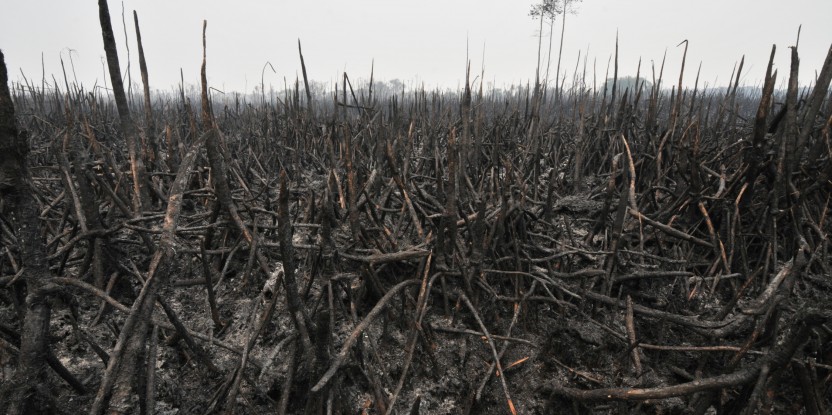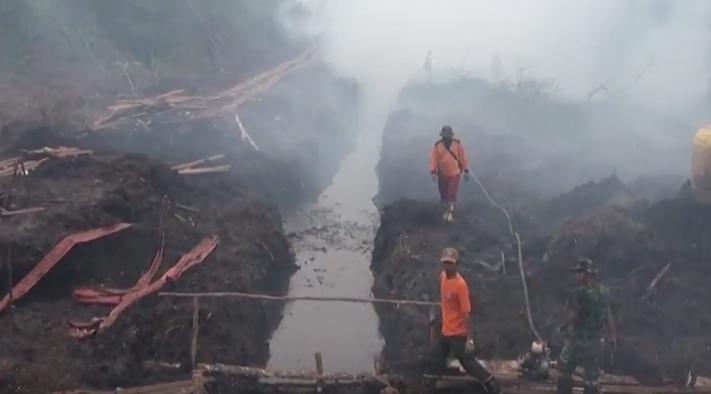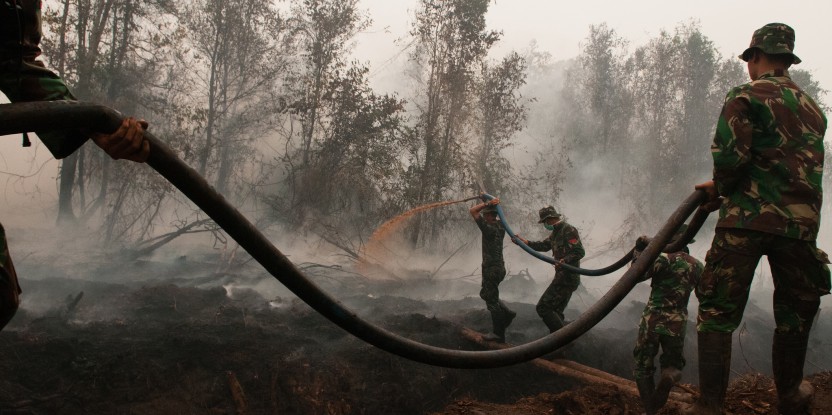The rainy season has begun in Indonesia, dousing most of the fires that have been burning across Sumatra and Kalimantan. Nature may have solved the problem for now—but the threat is far from over.
“Some parts of the country are going to be naturally drier in February and March—parts of Sumatra and eastern Kalimantan—and in an El Niño year, that will be more pronounced,” said Louis Verchot, Director of Forests and Environment at the Center for International Forestry Research (CIFOR).
“So we can expect another surge of fires,” he added.
The fires and the toxic haze they emit have had a major impact on people and the environment. Indonesia estimates that some 1.7 million hectares has been affected. Economic costs could rise to billions of dollars, and the country’s greenhouse gas emissions could reach new levels. More than half a million people have been treated for respiratory symptoms so far; the long-term health effects remain unknown.
IN THE TRENCHES
Authorities faced a massive task in battling the fires, even with international support. And with more fires likely, identifying which actions worked and which didn’t is essential.
One issue under consideration is the digging of canals, or ditches.
“The reason the government digs ditches is to get access to water, but that water comes from within the peatland,” Verchot said.
Peat is organic matter with a very high water table in it; this slows down decomposition, which is why the peat accumulates.
“When you dig a ditch, all the water comes out and into the ditch, which means the peat now is drier, deeper in the profile, so it burns more,” Verchot said.
Verchot and other CIFOR scientists are working with experts from Palangka Raya University in Central Kalimantan to measure the long-term effects of drainage and fire on the peatland. They have installed 22 field-based tools, known as R-SET-MH, to observe changes underground over time.
“We want to see the carbon loss due to drainage and belowground processes,” said Sigit Sasmito, a graduate researcher at CIFOR.
“We can also measure the benefits of re-wetting the peatlands.”
These data provide just one example of research that can support strategies to help overcome the problem.
But Verchot warns that long-term solutions must get underway sooner rather than later.
“This fire and haze, this event, was totally predictable. This problem can be solved,” he said.
“It is going to require strong political will. It’s going to require a lot of people doing things differently. And it’s going to require facilitation for people doing those things differently.”
And success will require more than enforcement.
“It also requires incentives, and creating the opportunities for people to do something to move off of these peatlands, and still find a way to make a living to ensure their livelihood for the future of their families,” Verchot added.
“That’s what this is all about—it has to be more of a human story. Solving it really means putting people in the center of the solution.”
THE BILLION-DOLLAR QUESTION
Research shows that millions of tons of carbon dioxide were emitted during the 1997–98 fires, contributing significantly to climate change. This year, the volume of emissions is expected to be the second worst on record.
Delegates at the upcoming UN Climate Change Conference in Paris will aim to achieve a legally binding and universal agreement on climate, with the aim of keeping global warming below 2°C. Forests and land use could enter the agreement in the form of REDD+, or reducing emissions from deforestation and forest degradation.
In 2010, Norway pledged to provide Indonesia with up to US$1 billion for REDD+.
Verchot said that Indonesia has made some strong commitments to REDD+ but structural reforms are still needed—and that requires money.
“There’s a billion dollars on the table right now from the Norwegian government and that has certainly spurred a lot of action. But a billion dollars compared to the value of the forest products industry, the pulp and paper industry and oil palm its not exceptionally large. It’s actually rather small,” he said.
“So without the assurance of some long-term sustained finance there to see this REDD mechanism through to accomplish these objectives, it’s going to be difficult for Indonesia to make a case that it is going to need to invest in all the structural reforms required to bring that about.”
Indonesia is working with experts to tackle the problem. As a first step, President Joko Widodo has instructed the Ministry of Environment and Forestry not to issue new licenses for peatland exploitation. President Widodo has said that the current momentum must be used to prevent future fires.
Verchot agrees.
“If the crisis passes and actions are not undertaken, it’s going to be forgotten and the opportunity will be lost,” he said.
“There’s a saying: you never waste a crisis. And the crisis here now is drawing considerable national and international attention to this issue.”
We want you to share Forests News content, which is licensed under Creative Commons Attribution-NonCommercial-ShareAlike 4.0 International (CC BY-NC-SA 4.0). This means you are free to redistribute our material for non-commercial purposes. All we ask is that you give Forests News appropriate credit and link to the original Forests News content, indicate if changes were made, and distribute your contributions under the same Creative Commons license. You must notify Forests News if you repost, reprint or reuse our materials by contacting forestsnews@cifor-icraf.org.


